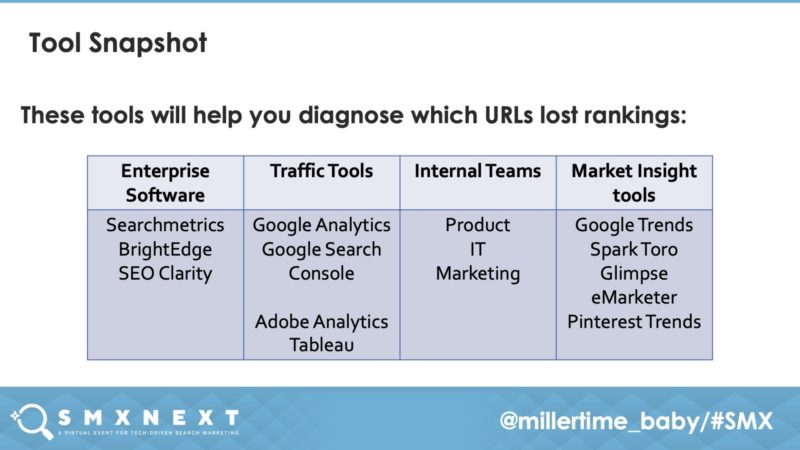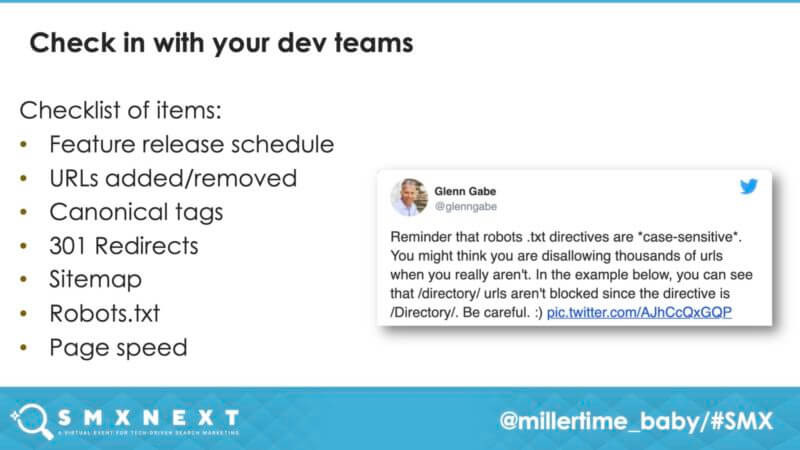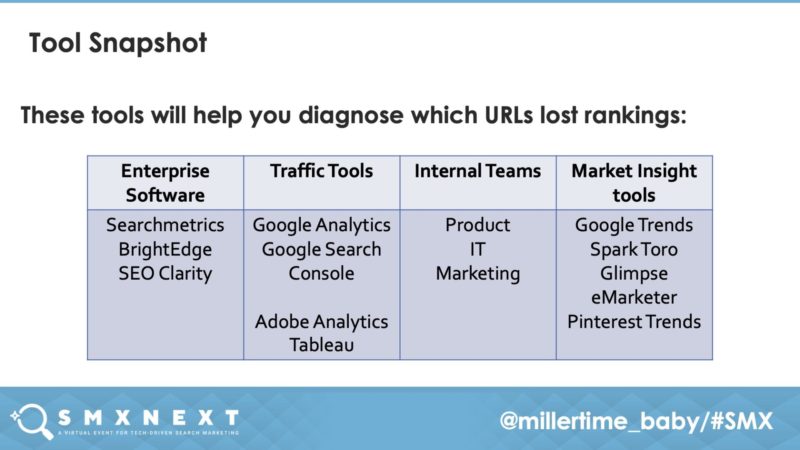When your rankings decline, your brand’s visibility decreases. That may also be accompanied by less traffic and, for many businesses, that means less revenue. Swiftly identifying the affected areas of your site and the factors that may have resulted in the decline can enable you to reclaim or even improve your rankings.
Holly Miller Anderson, former SEO product manager for Macy’s Tech, detailed her systematic approach and the tools she relies on to diagnose and fix rankings drops in a talk during SMX Next (free registration) this week.

Why your rankings might have fallen
Anderson noted the three possible causes for rankings declines and addressed how to diagnose each. “It’s either something that changed on your site, Google changed something or external factors are affecting your rankings,” she said.
Related: Essential SEO Guide: How to master the science of SEO
Something changed on your site. “This can take the form of a folder getting moved, code was updated or pushed live that broke something, your dev teams unknowingly created redirects, Googlebot is being blocked from crawling and indexing important pages or parts of your site because there was a change to the robot.txt file, maybe something happened to the site map,” she provided as examples of site changes that could negatively affect rankings, adding that these issues are generally easy to resolve.
Google changed something. An algorithm update may also cause ranking volatility. “Broadly speaking, if you notice a sharp decline in your rankings and traffic, it’s a good indicator that you need to dig in and find out where Google feels your site is falling short of expectations,” she said. If competitors within your sector also lost rankings, there may be a commonality that needs to be addressed, she added.
The Google Search Liaison Twitter account and Google Algorithm Update History page from Moz are two resources that Anderson recommends to verify whether an algorithm update actually occurred. Was There A Google Update, created by Search Engine Land News Editor Barry Schwartz, can also be used to surface algorithm update news based on date.
External factors in the market. These factors can range from competitors launching content that is more authoritative or comprehensive than yours to breaking news shaking up the search results for a given term to search behavior swings due to COVID-19, for example.
In the case of a competitor overtaking your rankings, SEOs can revisit their content to improve it. However, there are other scenarios, such as the coronavirus pandemic, in which things are “just out of our control,” she said.
Pinpointing the cause of a rankings dip
Anderson recommends using an enterprise software platform, Google Analytics, Google Search Console and the following checklist of questions to narrow down the possible causes behind a rankings decline.
Which high volume search terms lost rankings? If your high volume terms lost rankings, it may have been caused by a site change that made your page less relevant. Keeping a record of what changes were made and when can enable you to identify and resolve the issue.
Alternatively, your site may have been affected by an algorithm update. Keeping an eye on your competitors’ rankings can validate this explanation.
Did your rankings drop while direct competitors’ rankings increased? “The key here is to look for the isolated incident of your URL rankings dropping, while other competitors remain steady — that speaks more to something that was done on your site that can be rectified to regain those rankings,” Anderson said, noting that this may be tricky to navigate in verticals where expertise, authoritativeness and trustworthiness (E-A-T) factors are at play, such as in the financial, medical or other Your Money or Your Life (YMYL) sectors.

Did any indirect competitors overtake you in rankings? If this is the case, and you have not made any site changes, then those indirect competitors may have made investments in their content or improved their site architecture. Using enterprise software can help you get a better overview of any indirect competitors’ online visibility to determine if this is one of the causes.
Did your domain and your direct competitors’ domains lose rankings? An algorithm update may affect similar sites in your vertical, decreasing rankings across those sites. “At this point, you want to start researching what other SEO industry professionals are seeing in their data to better understand what the algorithm was targeting and how you can take steps to recover your rankings,” said Anderson.
Which specific area of your domain lost rankings? “Getting the answer to this question will help you backtrack to understand if rankings are suffering due to on-page content that was updated or if it has to do with technical limitations on your page,” she said, recommending that SEOs work with other internal teams to compare what changes might have led to the rankings dip.
An algorithm update may also result in a rankings decline for particular pages on your site: “For instance, when the Penguin update was released, it targeted pages where there were hundreds of links on the page,” said Anderson.
Identifying external factors that could affect your rankings
The search results page may change to accommodate what users are looking for. What users are looking for also changes as their priorities shift due to trends, disruptions in their daily lives or breaking news. Here are some tools and resources that Anderson uses to help determine whether a rankings decline may be associated with such shifts.
- Google Trends can tell you how popular a search term is and how popular it has been historically.
- Twitter is useful for recognizing events that may be affecting your customers and their buying behavior.
- SparkToro is an audience insights tool that can help you understand what organizations may be outranking you and which organizations or people you may want to collaborate with to increase your visibility.
- Glimpse is a tool that tracks emerging trends and can help inform your content strategy for greater relevance.
- Pinterest Trends provides insights on trending topics across Pinterest. It’s currently in beta testing.
- eMarketer provides market research as well as data on trends and how consumers are responding to them.
More from SMX Next
The post How to diagnose and fix a search rankings dip appeared first on Search Engine Land.
Source: IAB

